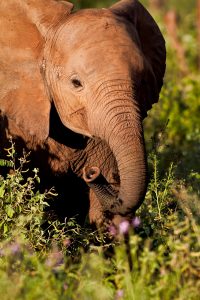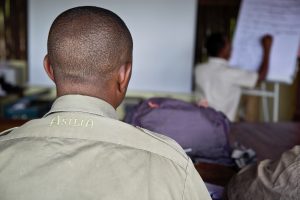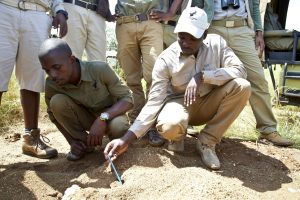Award-winning writer and photographer Stuart Butler always wondered how much work was involved in becoming a safari guide. He got his chance when the acclaimed safari and conservation group Asilia Africa let him be a “fly on the wall” at their wildlife guide training camp in Tanzania’s Tarangire National Park from mid-March until mid-April 2016. Here is the second of his series of dispatches from the time he is spending in the field, which includes interviewing aspiring guides and training staff, learning how to track wildlife, and partaking in bush walk training, fly-camping experiences and night safaris.

A guide pretending to be an ostrich digging his head into the sand during an ecology lesson (Stuart Butler)
In my first week of training I learnt all about the birds that might be encountered on a safari. Actually, let me rephrase that. The Asilia guides, who are among the best around, learnt all about the birds. I, however, immediately forgot everything I was told about the birds. This week though I have learnt all about ecology. I was feeling confident going into this set of lectures. I knew stuff about ecology. I even knew how to spell it.

Baby elephant in Tarangire National Park (Stuart Butler)
Ecology then is “the study of how organisms relate to one and other and to their environment,” but it’s a lot more interesting than this dry definition lets on. Pietro Luraschi, head guide for Asilia and the man leading the guide training course, explained the nitrogen cycle to us and the water cycle and he told us all about the various interactions between the plants and creatures likely to be seen on the East African savannas. He also spent much of one lecture describing, in passionate detail, the lifecycle of the fig wasp and how, for pollination, figs are reliant on fig wasps to fertilise them. It didn’t seem to have much relevance to the “lions and leopards” kind of questions that most safari visitors are likely to ask, but it had the classroom riveted nevertheless. Basically, fig pollination is done by a female wasp entering into the fig through a tiny hole and laying her eggs inside it. Shortly thereafter a bunch of tiny baby male fig wasps hatch and then, using a penis that is one of the largest in the animal world, impregnates the female wasps just before they emerge. The male then dies, the already up-the-duff female hatches, and buzzes off to another fig and lays her eggs there. There was also something about another species of wasp being involved that had to cut a hole in the top of the fig so that the female could escape. However I forgot the details of that as I was too busy wondering how many wasps with giant penises I had eaten inside my figs over the years.

Busy with lessons (Stuart Butler)
One of the other more memorable ecology lessons revolved around the never-ending battle between trees and grass on the savanna. From what I understood, when it grows up the savanna would actually dearly love to be a woodland. Maybe even a jungle. But life, in the form of herbivores, soil types and fire, has always been cruel to the savanna’s woodland ambitions and prevented it from achieving its dreams. Every time the trees and bushes start to get ahold, the elephants, giraffes and impalas knock them back, or the soil type proves all wrong for bushes to burst into trees, and then, just as things are going better, along comes nasty old fire and burns all those tender young trees back to a tinder. Grass also suffers from many of the same problems, but it bounces back quicker than bushes and trees and so the savanna remains mainly just endless horizons of golden grass with bigger ambitions.
And all this talk of grasslands and insects reminds me of something I was once told by a highly regarded Kenyan entomologist: “One in every species of animal across the world is a beetle,” he had enthusiastically said as we sat on a golden-grass hilltop on the Masai Mara-Serengeti border. “All have their role to play, but perhaps it’s the dung beetles that are the most popular with safari-goers.” And it’s true, everyone likes to watch a dung beetle comically roll a perfect ball of dung along the ground, but few of us really give them a second thought. Perhaps we should. My man went on to explain how, without dung beetles, “After the wildebeest migration the entire Mara eco-system would be covered in a one-inch (2.5 cm) deep layer of dung.” That’s some 4500 sq km of savanna (1500 sq km for the Masai Mara National Reserve and 3000 sq km for the conservancies and communal lands outside) that would have a thick layer of dung spread across them.

In the bush learning about harvester ants (Stuart Butler)
Of course it hasn’t all been about classroom education this week. There have been volleyball matches, bird-watching trips (in which I once again proved that I had an unnatural ability to misidentify the most obvious of birds), expeditions to find and photograph the perfect baobab tree, (a near impossible task in a park like Tarangire, which is so blessed with these most grand and beautiful of trees) and a competition to do the best animal noise impersonation (which was an easy win for Asilia’s head chef John De Villiers and his impression of a man kicking a dog).
So there you go, ecology — I told you it was interesting. Not only does it explain how we get the oxygen that keeps us alive, but it also allows us to talk with a straight face (well maybe not me) about giant penises and a world covered in excrement.
In next week’s blog I leave the wildlife guides behind, put on a pinny, and join the trainee bush chefs and waiters and waitresses.
To read the intro to the series, click here.
To read part one of the series, click here.

